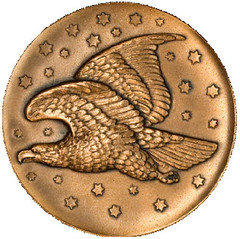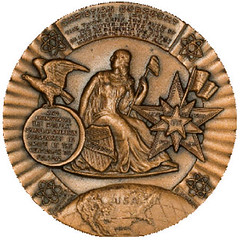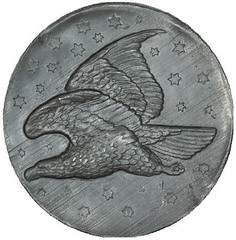
PREV ARTICLE
NEXT ARTICLE
FULL ISSUE
PREV FULL ISSUE
TOIVO JOHNSON'S COIN DESIGNER MEDAL SERIES
Dick Johnson submitted the following item, inspired by an article by Len Augsberger in The E-Gobrecht, an electronic publication of
the Liberty Seated Collectors Club (see
www.lsccweb.org
). To subscribe to The E-Gobrecht, email editor Bill Bugert at
wb8cpy@earthlink.net
.
-Editor


Len Augsburger had an interesting article in the E-Gobrecht that arrived this week. Incidentally that is an interesting internet monthly newsletter on Liberty Seated coins and their American artist-creator, Christian Gobrecht. Editor Bill Bugert does a great job. Len had purchased a Gobrecht item on eBay, a lead trial strike of the reverse of a medal in honor of Gobrecht, and revealed the seller was the son of the "medal designer." There's a lot more to the story however. The issuer was a Maine numismatist, Toivo Johnson (1913-1973) and no relation to the present writer. In 1961 he developed the idea to issue a series of medals to honor coin engravers. His idea was to reproduce the artist's most popular design on one side and a tribute to the artist on the other. He first approached William Louth, president of Medallic Art Company. He came to New York and told Bill of his plan. He wanted Medallic Art to strike the medals. Bill liked the idea of honoring coin designers, but not reproducing the coin design. This was still the era when exact coin images were verboten -- illegal -- and he rejected that concept. He suggested to Toivo to have the artist's portrait on one side and the other a tribute to the artists' numismatic creations. He could have a top artist create the models. Toivo was firm in his mind, that was not what he wanted. The two exchanged words. Toivo left with the rejection ringing in his ears. He would show that Bill Louth what he wanted. So he went to Medallic Art's competitor, Metal Arts in Rochester, New York. Here they would do whatever Toivo wanted, and would change each coin design slightly to get around the illegality of reproducing an exact coin design. The designs were not modeled but machine engraved where dies are cut by a tracer controlled pantograph operated by a factory artist. That "artist" was Robert Stephen Schabel (1909-1995). Tracer controlled engraving starts with an oversize drawing, an outline of the design. The machine operator rides a stylus across that outline, following each line while a rotating cutting tool cuts that line into the surface of the die. Then he goes back and by hand and eye determines how deep the relief should be for each element of the design. The goal is to create the cavities of relief in a die -- in negative -- to strike the medal. Such engraving does not allow for error or experimentation. It cuts a die at one time and that's it! This in contrast to a "modeled" design in which the artist works in clay and can experiment, changing and improving a relief element as many times until satisfied with the final result, or go back and start all over. In the struck piece a tracer-controlled design is somewhat flat and lifeless. On the other hand a modeled design is more realistic, lifelike. More artistic effort is usually put into a modeled design. To his credit, Schabel's designs were exceptional, perhaps the best of his career. He produced the dies for six medals for Toivo's Coin Designer Medal Series. In addition to the Gobrecht medal that Len mentions in is article, the series honored Victor David Brenner, Charles Barber and Augustus Saint-Gaudens issued in 1962, plus ancient coin engraver Evanetos, James B. Longacre, and that Christian Gobrecht issued in 1963. Years later Toivo Johnson went back to Metal Arts company and had two more medals made, here again with dies cut by Schabel, the American Freedom Medal and the Maine Sesquicentennial Medal. Both of these were issued in 1970. Len mentioned that the seller told him the Gobrecht medal "is the most popular in the series because of the space theme" (of an eagle in flight); that "apparently there are a lot of space collectors out there pursuing different kinds of space-related memorabilia." That is an example of nonnumismatic nonsense! If we examine the number of medals sold at auction the Saint-Gaudens medal was four times more popular than the Gobrecht. Only the Longacre medal has fewer auction appearances than the Gobrecht, with the Brenner the second most popular. When I was a medal dealer, I received a call one day from the son of Toivo Johnson after the father's death. He still had on hand a quantity unsold of the Coin Designer Medals twenty-five years after they were first issued. I didn't buy them from him. But the thought crossed my mind: What if Toivo had listened to Bill Louth and issued more artistic, modeled medals for that series. Would they have sold out?

Lead Trial Strike
To read the complete E-Gobrecht issue, see:
The E-Gobrecht July 2010 (Whole # 66)
(www.seateddimevarieties.com/66-E-GobrechtVolume6,Issue7.pdf)
The Numismatic Bibliomania Society is a non-profit organization promoting numismatic literature. See our web site at coinbooks.org. To submit items for publication in The E-Sylum, write to the Editor at this address: whomren@gmail.com To subscribe go to: https://my.binhost.com/lists/listinfo/esylum All Rights Reserved. NBS Home Page Contact the NBS webmaster 
|